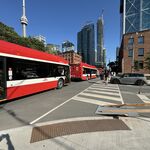smallspy
Senior Member
As I have said before (and I think there is some who agree) the mix of via/freight on the KW line is not that much different than during the 4 decades or so that GO ran hourly off peak on the Lakeshore W line (ie. more freight on KW but way less via).
That is completely incorrect.
The whole reason why GO was able to be started in 1967 was because CN had built a new freight yard north of the City and had pulled virtually all of their freight trains off of the lines that GO was then able to use. GO needed the capacity and track time on those lines that the freight trains occupied.
The section of track between Georgetown and Bramalea now sees about 30-40 freight trains a day, on top of the GOs and VIAs that run up there. Since the opening of MacMillian Yard in 1965, CN has run maybe 5 or 6 freights a day on average on the sections of the Kingston Sub and Oakville Sub where GO has been providing hourly service, and they've run even fewer trains on average in the past 20 years.
Dan
Toronto, Ont.




